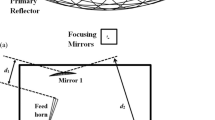Abstract
We present the design, implementation, and characterization of the optics of ALMA Band 1, the lowest frequency band in the most advanced radio astronomical telescope. Band 1 covers the broad frequency range from 35 to 50 GHz, with the goal of minor degradation up to 52 GHz. This is, up to now, the largest fractional bandwidth of all ALMA bands. Since the optics is the first subsystem of any receiver, low noise figure and maximum aperture efficiency are fundamental for best sensitivity. However, a conjunction of several factors (small cryostat apertures, mechanical constraints, and cost limitations) makes extremely challenging to achieve these goals. To overcome these problems, the optics presented here includes two innovative solutions, a compact optimized-profile corrugated horn and a modified Fresnel lens. The horn profile was optimized for optimum performance and easy fabrication by a single-piece manufacturing process in a lathe. In this way, manufacturability is eased when compared with traditional fabrication methods. To minimize the noise contribution of the optics, a one-step zoned lens was designed. Its parameters were carefully optimized to maximize the frequency coverage and reduce losses. The optical assembly reported here fully complies with ALMA specifications.









Similar content being viewed by others
References
A. Wootten, and A. Thompson, ”The Atacama Large Millimeter/Submillimeter Array,” Proceedings of the IEEE, vol.97, 1463 (2009).
H. Rudolf, M. Carter, and A. Baryshev, ”The ALMA Front End Optics—System Aspects and European Measurement Results”, IEEE Transactions on Antennas and propagation, vol. 55, (2007).
James W. Lamb, ”Low-Noise, High-Efficiency Optics Design for ALMA Receivers”, IEEE Transactions on antennas and propagation, vol. 51, N°.8, (2003).
J. Di Francesco et al.,”The science cases for building a Band 1 receiver suite for ALMA”, arXiv:1310.1604v3, (2013).
T. Huang et al., ”Development of Band-1 receiver cartridge for Atacama Large Millimeter/submillimeter Array (ALMA),” in Proc. SPIE 9153, Millimeter, Submillimeter, and Far-Infrared Detectors and Instrumentation for Astronomy VII, p. 14. (2014).
μWave Wizardtm, Mician GmbH, software description. Available: http://www.mician.com/.
R. Gonzalo, J. Teniente, and C. del Río, ”Improved Radiation Pattern Performance of Gaussian Profiled Horn Antennas”, IEEE Transactions on antennas and propagation, Vol. 50, N°. 11, (2002).
J. Graeme L, ”Analysis and Design of TE11-to-HE11 Corrugated Cylindrical Waveguide Mode Converters,” Microwave Theory and Techniques, IEEE Transactions, vol. 29, NO. 10, pp. 1059, 1066 (1981).
C. Granet and Graeme L. James, ”Design of corrugated horns: a primer,” Antennas and Propagation Magazine, IEEE, vol. 47, N°. 2, pp. 76-84 (2005).
P.J.B. Clarricoats and P.K. Saha, ”Propagation and radiation behaviour of corrugated feeds. Part 1: Corrugated-waveguide fe bed,” Proceedings of the Institution of Electrical Engineers, vol. 118, no. 9, pp. 1167-1176, 1971.
High Frequency Structure Simulator, Ansys Academic Research, release 15.0.2.
N. Reyes, et al., ”Design of the optical system for ALMA Band 1,” in Proceedings of SPIE Vol. 9145, p. 91451W (2014).
A. Gonzalez, et al., ”Alternative optics design for the ALMA Band 1 receiver (35–52 GHz),” in European Conference on Antennas and Propagation (EuCAP), pp. 1-4 (2015).
M. Carter, et al., ”ALMA Front-end Optics,” ALMA, Design report FEND-40.02.00.00-035-B-REP, (2007).
M. Tejada, ”Fatigue and creep behavior of ALMA Band-1 lens,” Millimeter Wave Lab – U. Chile, Santiago, Chile, Mech. Rep., (2015).
J. L. Volakis (editor), ”Antenna Engineering Handbook”, Chapter 18, 4th Edition, Mc Graw-Hill, (2007).
T. Morita and S. B. Cohn, ”Microwave lens matching by simulated quarter-wave transformers”, IRE Transactions on Antennas and Propagation, vol. 4, no. 1, pp. 33-39, 1956.
MIG WASP-NET, software description. Available: http://www.mig-germany.com/.
Acknowledgments
This work was supported partially by CONICYT grant CATA Basal PFB06; ALMA-CONICYT Project 31120005 and 31150012; FONDECYT projects 11140428 and 11151022; CONICYT Grant AIC-27; QUIMAL fund project 140002; and ESO-Chile Joint Committee. We thank National Instrument for the donation of software licences. Finally, we would like to especially thank José Pizarro for his support and manufacturing the horns and the lens used in this paper.
Author information
Authors and Affiliations
Corresponding author
Rights and permissions
About this article
Cite this article
Tapia, V., González, A., Finger, R. et al. High Efficiency Wideband Refractive Optics for ALMA Band-1 (35-52 GHz). J Infrared Milli Terahz Waves 38, 261–275 (2017). https://doi.org/10.1007/s10762-016-0331-4
Received:
Accepted:
Published:
Issue Date:
DOI: https://doi.org/10.1007/s10762-016-0331-4




